Good gardening equipment is an absolute must, and this is something that homeowners or farmers all around the world can agree on.
No one wants a garden with leaves lying around and mud caked on the flower beds. Having the correct rakes can help you get rid of the waste in your garden, but it will also keep your plants healthy and beautiful.
Choosing the right rake can make or break your gardening efforts. For instance, a metal rake may be the best option for professional-grade gardening tasks like spreading, moving, or leveling soil.
However, if you need to get rid of leaves, a plastic garden rake is a better choice.
Rakes come in a variety of shapes, sizes, materials, and designs, each with its own set of advantages and disadvantages.
Read on to learn about fourteen unique types of rakes and the jobs they excel at.
| Type | Usage |
| Garden Rake | Spreading or moving soil or mulch. |
| Leaf Rake | Raking light objects like leaves or grass clippings. |
| Thatch Rake | Dethatching the lawn (removing a layer of dead grass). |
| Shrub Rake | Raking and cleaning narrow spots. |
| Leaf Scoop Rakes | Scooping and transporting leaves, grass clippings, and other light garden waste. |
| Lawn Rakes | Multitasking (raking, mulching, or leveling soil). |
| Landscape Rake | Larger-scale yard maintenance. |
| Stone Rake | Distributing gravel, stones, or mulch. |
| Hand Rake | Tending flower beds and cleaning out planters. |
| Roof Rake | Removing debris or snow from the roof. |
| Lake Rake | Removing algae and weeds from bodies of water. |
| Berry Rake | Harvesting berries. |
| Concrete Rake | Working with cement to achieve an even finish. |
| Hay Rake | Gathering hay from the field. |
Table of Contents
1. Garden Rake

The garden rake, one of the oldest and most useful pieces of garden equipment, is a staple in any gardener’s shed.
For many, the first thing that springs to mind when hearing the word “rake” is a picture of a garden rake.
Garden rakes have stable, straight handle and short, firm metal tines that are very solid and don’t flex.
A high-quality garden rake should be one of every homeowner’s go-to tools for maintaining their lawn or flower beds.
A garden rake is generally used for spreading or moving soil or mulch.
However, a garden rake is not the best tool for handling leaf piles.
The tines on these tools are too short to be beneficial when raking leaves. Additionally, the strong metal tines, which are intended for working in the soil, may cause harm to grass or flowers.
Also, this rake is rather heavy, which might make raking leaves a difficult and unpleasant task.
2. Leaf Rake
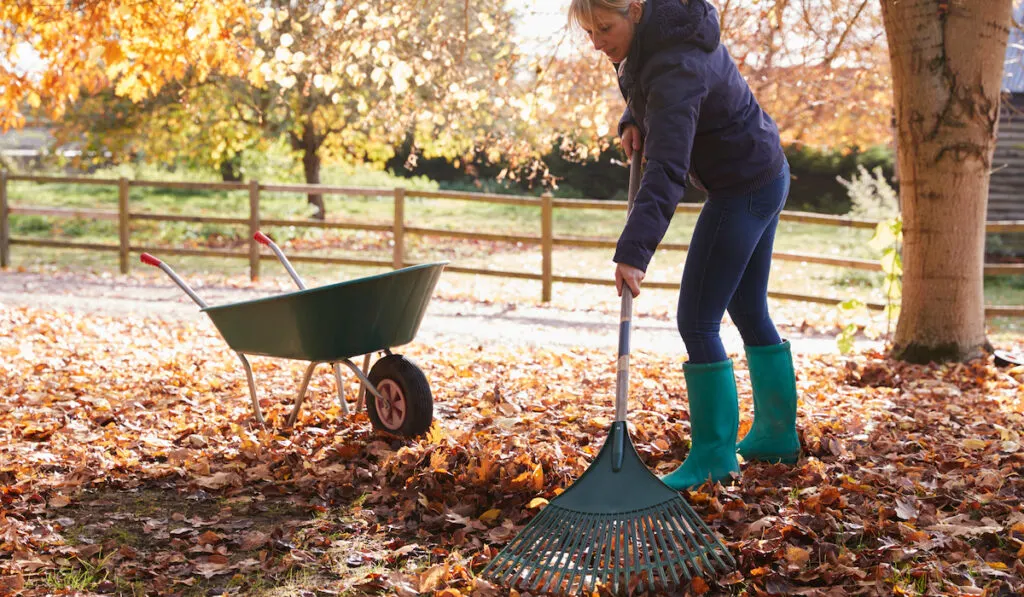
Nowadays, most leaf rakes are constructed of plastic, which makes them lightweight, durable, and easy on the grass.
You can use them to quickly and efficiently rake up leaves, as well as grass clippings and other yard waste.
A leaf rake’s head can be fan-shaped or triangular, and it typically has bent tines, which makes it an excellent tool for scraping and moving lightweight objects without damaging the raking surface.
3. Thatch Rake

If you want a healthy lawn, you need to dethatch it, which means removing the layer of dead grass along with other organic waste that sits between the growing healthy grass and the soil layer.
The head of a thatch rake may have a single set of tines or two. The grass thatch can be broken up using one side of the rake, and the excess can be brushed away with the other.
To use, place the rake’s blades slightly beneath the grass’s level and pull it towards you. Be careful when using these rakes, as the tines are designed to be very sharp.
4. Shrub Rake
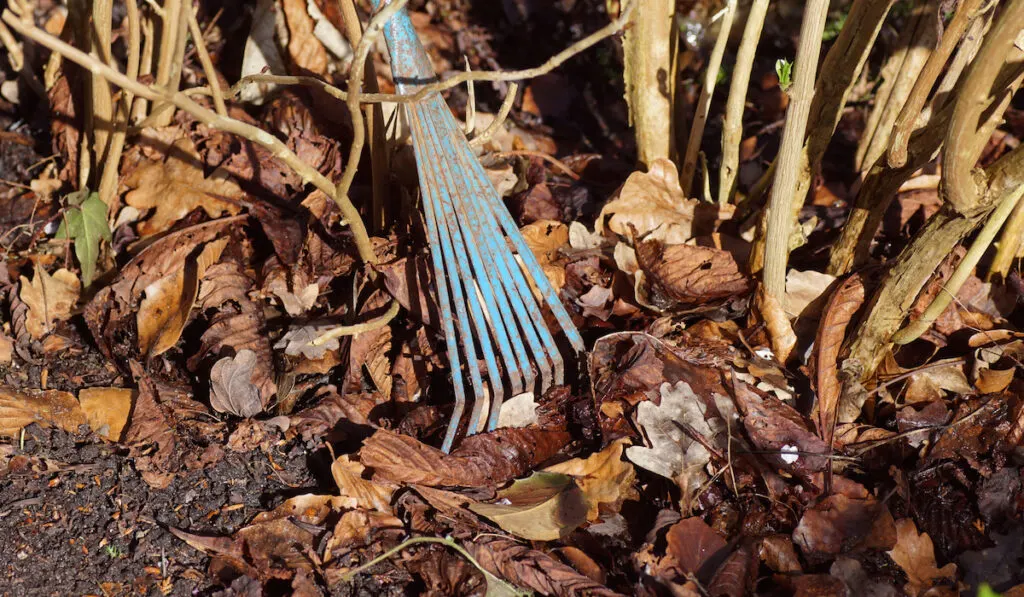
These rakes resemble standard leaf rakes, but their narrower head and fewer tines set them apart.
A shrub rake has a fan-shaped head and shorter tines than a regular leaf rake, which are often no more than ten inches in length.
The narrow heads of these rakes make them ideal for use in confined locations. Unlike trying to use a massive leaf rake over plants, garden corners, or other limited areas, you can easily and quickly sneak into them and clean them out.
The shrub rake can be made out of either metal or plastic.
5. Leaf Scoop Rakes
A leaf scoop rake is an excellent tool to have on hand in the fall for clearing the garden of fallen leaves.
If you use a traditional leaf rake, you’ll collect the leaves in a pile, and then you will need to shovel them into a wheelbarrow or compost bin.
A leaf scoop rake has a pair of jaws that can open and close over the leaves. This makes it simple to grab a portion of the pile you generated and transport it from one location to another.
A leaf scoop rake is made of plastic and is not very durable, so it shouldn’t be used to transport any heavy objects like rocks or gravel.
6. Lawn Rakes
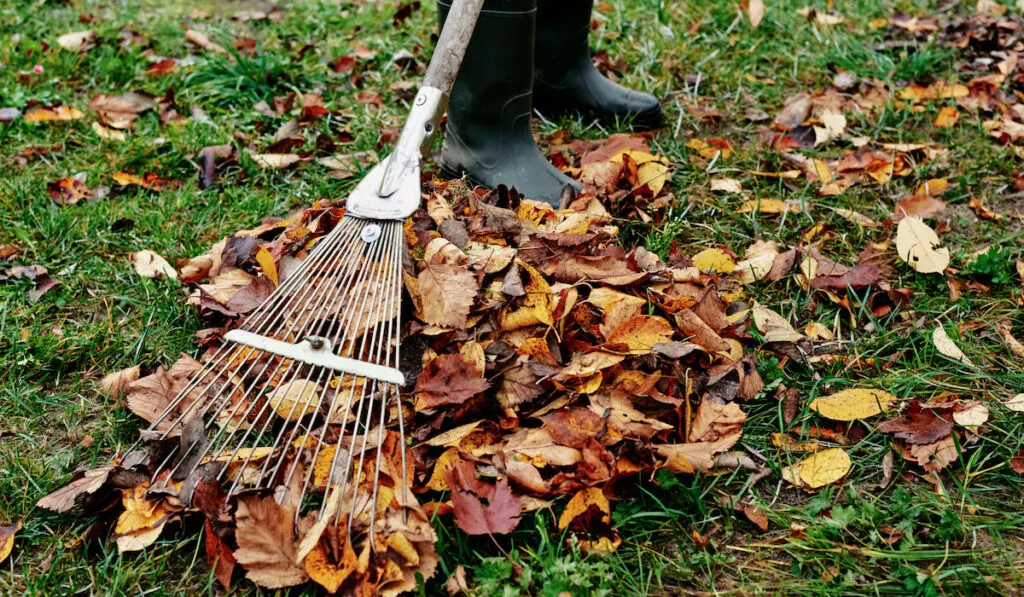
Lawn rakes are a fantastic all-around rake model to have on hand. They look a lot like leaf rakes, so people often mistake them for each other.
Lawn rakes have a lengthy, straight handle and a fan-shaped head made of long, thin metal tines.
As their name suggests, lawn rakes are a superb tool for doing complete lawn care tasks. You can swiftly rake leaves or level the ground with them.
Though they are most useful for lawn maintenance, these rakes have a wide range of applications.
Their strong yet flexible teeth make them ideal for raking, mulching, or leveling soil, sand, or gravel in the garden.
7. Landscape Rake
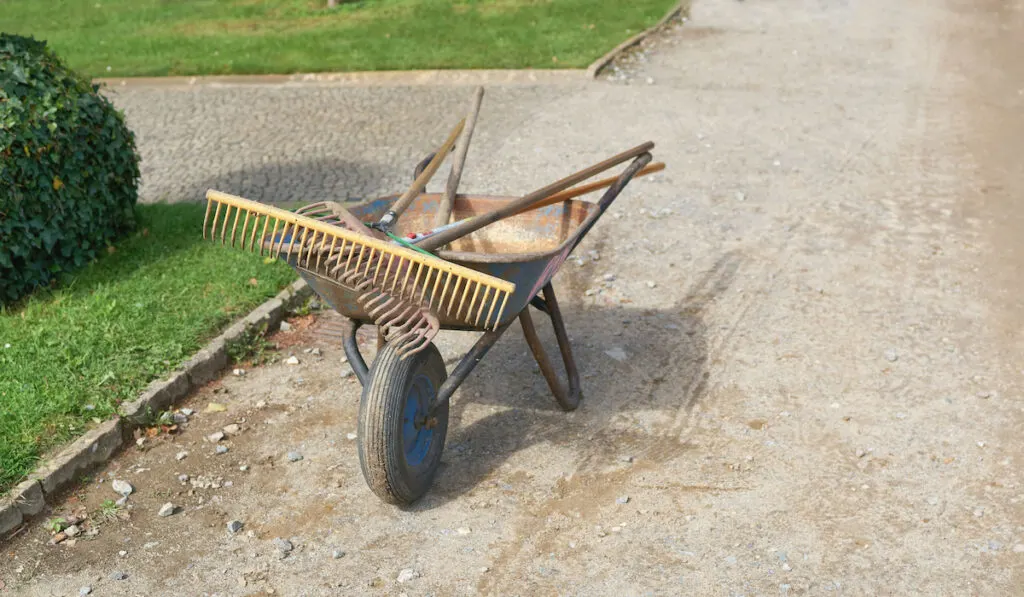
Most households won’t have this particular model of rake because it is more specialized.
In most cases, a landscape rake will be utilized by a landscaping company for larger-scale yard maintenance.
Typically composed of steel, a landscape rake has a wide, flat head and is built to last. It is used to shift large amounts of sand, gravel, or soil in order to even out the ground.
They can also be used to remove stones and trash from the ground or prepare the surface for planting or sowing.
A landscape rake’s wide head makes it fast and easy to cover a lot of ground in a short amount of time, but the tool’s relatively large gaps between its tines make it inefficient for removing finer debris or stones.
8. Stone Rake

Stone rakes are also known as gravel rakes and tarmac rakes.
These rakes may look like the standard garden rake that homeowners have in their toolsheds, but they are much more durable and built to withstand the demands of more difficult tasks.
A stone rake’s head will be broader, and its tines will be thicker and more widely spaced than those of a garden rake.
These rakes are able to withstand heavier workloads because their rigid metal tines can pick up and move more robust materials without breaking.
They work nicely for distributing gravel, stones, or mulch across a surface.
9. Hand Rake
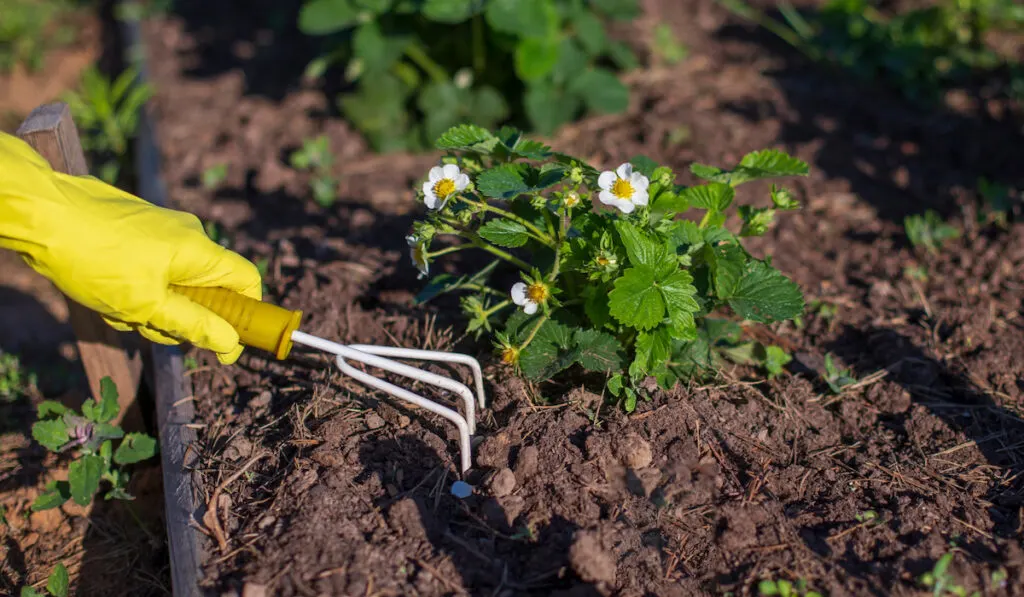
You can think of a hand rake as a miniature version of a regular rake.
Hand rakes are perfect for gardening in tight spaces since you have more control over the rake’s motions. A hand rake is an indispensable tool for tending flowerbeds and cleaning out planters.
A high-quality hand rake should have a solid metal head and rigid tines. The handle can be made of wood or metal. However, hardwood handles are preferable for ergonomics and comfort for users.
10. Roof Rake

Because of their intended use on rooftops, roof rakes are among the lightest rakes on the market.
This is due to the fact that cleaning a roof with a rake is a physically demanding task, regardless of whether you use a ladder or reach from the ground.
Typically, roof rakes are used to sweep snow off the roof, as this reduces the weight that could cause harm to the roof.
Roof rakes are also useful for clearing fallen leaves and other debris that might accumulate over time.
A roof rake typically has an extremely long or extended handle, allowing the user to stand well back from the edge of the roof while clearing away debris or snow.
11. Lake Rake
A lake rake is a professional tool you won’t need unless you maintain a lake or pond on your property.
Lake rakes, also known as ‘aquatic weed rakes’ and ‘pond rakes,’ are made specifically for clearing waterways of algae and weeds and are an essential piece of equipment for maintaining perfect water quality.
A lake rake’s handle is typically quite long, enabling the tool to be used from land or on a boat.
However, some lake rakes come with noticeably shorter handles but are attached to a rope. To get rid of algae and weeds in the water with a shorter rake, you have to throw it into the water and pull it back to shore with a rope.
12. Berry Rake
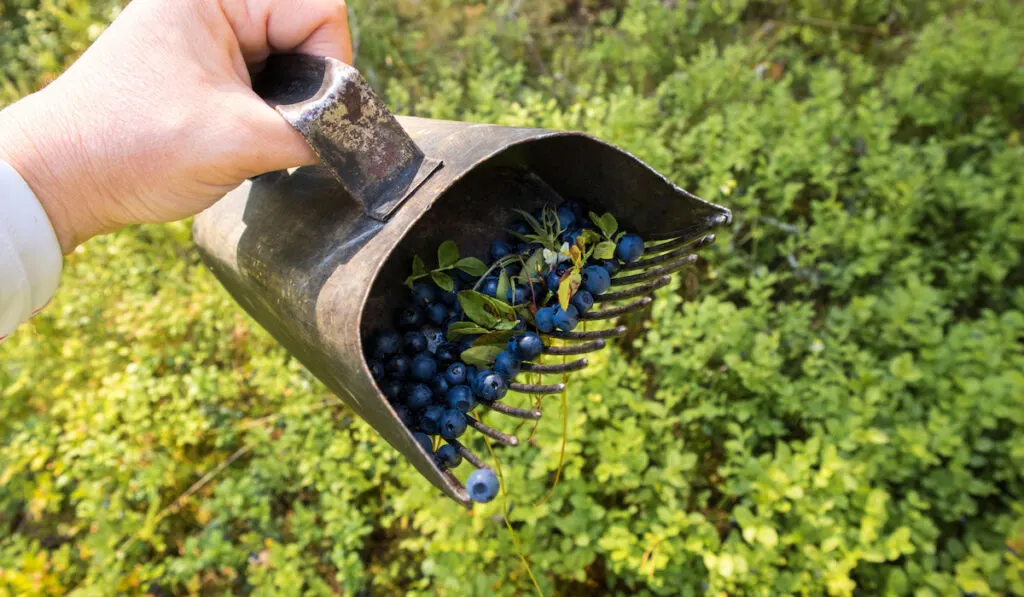
These rakes, which are often referred to as ‘berry picking rakes,’ are quite small and have heads that are formed like containers or miniature buckets.
Berry rakes are designed to quickly and gently collect berries by pulling the rake’s head over the plant’s branches.
A berry rake is a fantastic time-saving piece of gear that will allow you to harvest the maximum number of berries from your berry bushes.
13. Concrete Rake
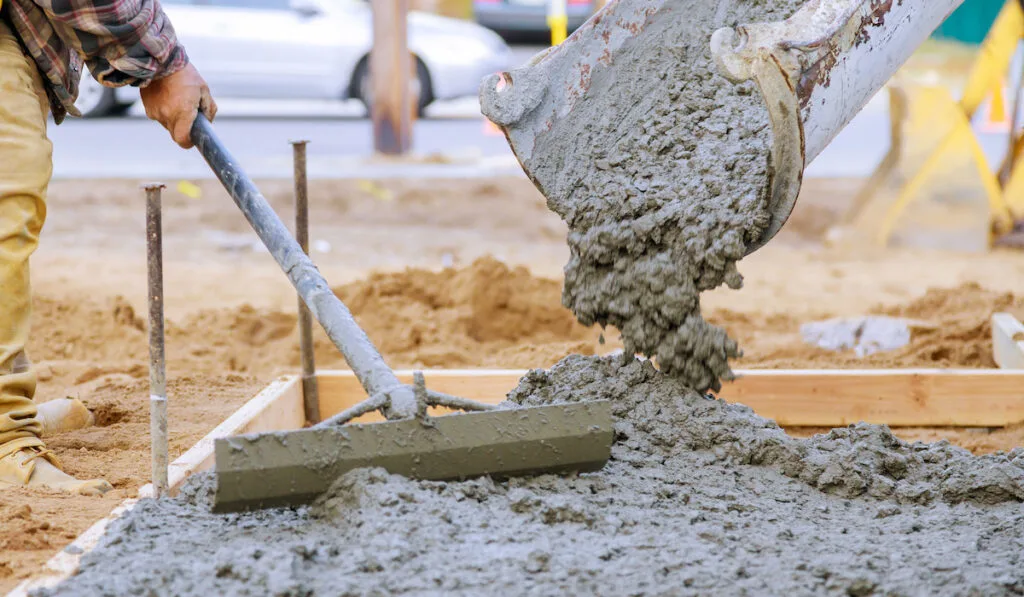
When constructing concrete walkways or any outdoor space, a concrete rake is a necessary tool.
A concrete rake is designed specifically for use when working with cement. It is used to move the concrete into place before it sets and to achieve an even finish.
The heads of these rakes can have a textured finish on one side, but the other side must be completely flat. The tool’s flat side is used to level out the concrete and provide a smooth surface.
14. Hay Rake

A hay rake is an indispensable tool for any small farm, as it may be used for gathering hay from the field as well as spreading it across the field to dry in the sun.
Hay rakes, like landscape rakes, have broad heads and rigid tines that allow them to quickly cover a lot of ground.
Some hay rakes may be hooked up to the rear of a tractor and towed behind it, making the task much quicker.

Metal vs. Plastic Rake
Your rake’s quality will depend on the materials used to construct it.
The use of a plastic rake has certain benefits. Plastic rakes are affordable due to their low production costs.
The second advantage is that plastic rakes are much easier to carry. Because of their lightness, they are perfect for people of all ages and abilities.
High-quality metal rakes, on the other hand, are so robust that they won’t break or bend under any typical usage.
Metal rakes are superior in terms of durability and longevity compared to their plastic counterparts, but their weight makes them problematic for gardeners with weaker muscles.
If you have a long task ahead of you, it may make you tired much more quickly.
Also, rust can develop on metal if it is not protected from the elements and thoroughly cleaned after each use.
Final Thoughts
Any collection of gardening equipment would be incomplete without a rake since it is one of the most useful tools for gardening and general duties.
When in a hardware store, it’s easy to grab the first rake that catches your eye. However, giving some thought to the specific needs at hand might help you find a tool that will serve you properly.
Common uses for a rake include cleaning up leaves and other plant debris from yards or leveling the soil surface before sowing and planting.
There are, however, specialized rakes available for more targeted tasks. A rake can be used to clean the pond or the roof, and some are designed for heavier tasks like moving stones or larger piles of soil.
Among the different rakes described in this article, you can select the one that is tailored to your needs.
Resources
- https://www.homestratosphere.com/types-of-rakes/
- https://www.lawnstarter.com/blog/lawn-care-2/guide-to-rakes-types-history-tips/
- https://www.oldhouseonline.com/review/garden-rake/
- https://gardenersbytrade.com/steel-vs-plastic-rake-does-it-make-a-difference/
- https://www.trees.com/gardening-and-landscaping/types-of-rakes#Berry-Rake
- https://www.lawnstarter.com/blog/lawn-care-2/guide-to-rakes-types-history-tips/
